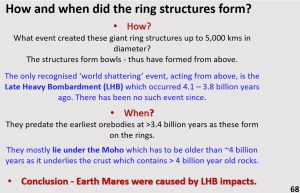
These notes are transcribed from my African Webinar which can be viewed at
Start at about 5 minutes to get straight into it.
We’ll now look at the geological evolution of Africa from the surface right down to 2,900 km depth using seismic tomography.
This image shows enhanced Africa in the top row with the structures and mines superimposed in the bottom row. It can be seen that the ring structures in particular vary in size as we descend, with the largest at 400 km depth.
The surface mines seen in Landsat correlate best with the 400 km structures. A large west-facing semicircle can be seen on Landsat and tomography at the 100, 300 and 400 km levels. A semicircle of 5,000 km diameter lies under where the mid-Atlantic ridge is at the surface? This needs explaining.
The formation of the Lithosphere.

This figure shows the surface Landsat rings, the 800 km deep seismic tomography section B and then a stacked perspective view of the plan tomography from 75 km to 400 km depth. The coloured cones illustrate the morphology of the ring structures with depth. However, this is about 200 times exaggerated vertical scale as can be seen if you correlate them with the 800 km deep seismic tomography section B. If you compress the sections to scale then the cone structures have the appearance of the bowl structures in section B-B’.
The right-hand side of the image shows my interpretation of how the lithosphere formed by lava extrusion during the Late Heavy Bombardment. It is important to realise that only 1 mm per year deposition of lava would form a lithosphere 300 km thick over 300 million years. I would have expected the lithosphere to be a much thicker rigid outer layer on earth.
My interpretation of the dry, relatively unaltered lithosphere now being only 100 – 500 km thick is that Earth has got hotter as it has compressed and the heat is gradually insitu resorbing the lithosphere from the core upward.
That the common concept that the early Earth was a hot nearly molten ball is wrong is shown by the almost universal deep-water submarine lithologies and water borne life (Bell et al. 2015) in the late Hadean 4.3 – 3.8 billion years ago. This suggests oceans covered the Earth in the Hadean and that the earth had probably much the same surface temperature as now.

Do we have a nearby example of what the Late Heavy Bombardment did to a planet (Alt et al. 1988, Hiesinger et al, 2010, Jones 2005)? The moon gives us the best example and can be seen most nights. If we compare the African tomography with the Luna mares, we can see there is a close correlation in size, shape, pattern and in the morphology of how the rims form.
Thus, we can be reasonably certain that what we see as structural geology in seismic tomography beneath the Moho was caused by the Late Heavy Bombardment from 4.1 to 3 .8 billion years ago (Hiesinger et al, 2000, Hiesinger et al, 2010).

Conclusion
The table summarises how and when the ring structures formed. The conclusion is that the lithosphere on earth formed by Late Heavy Bombardment impacts.
Agree or disagree. If you Disagree please send me a note explaining where I have gone wrong. I’ll listen to all and start a dialogue.
Only one more section to go now to complete the papers transcribing the African webinar.
Share this with your colleagues.

